Updated: 17-Feb-2020
Company founded by Glenn H. Curtiss, an American pioneer, who appears in the photograph of his historical flight from Albany to New York in 1910, in his Curtiss D with a water-cooled Curtiss 8-cylinder V-engine that gave 60 hp.
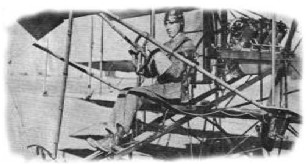
"Glenn H. Curtiss"
-His story begins as a motorcycle rider. The bikes he rode had engines he had made himself.
-His introduction to aeronautics might have started in 1903 when he was commissioned to motorize the small Baldwin airship. It was an air-cooled, 2-cylinder, V-engine that only gave 7 hp at 1,200 rpm with a displacement of 60 cu. in., which was the A-2 engine.
-Glenn H. Curtiss was an engine builder for motorcycles and one of these was the two-cylinder, 7-hp V-engine shown below.
-It was the A-2 we mentioned before.

“Curtiss A-2” (PiP)
-It was initially installed on the first airship of the US Signal Corps: the Thomas Scott Baldwin.
-Due to insufficient power, a different engine was installed on the second dirigible, this time with 4 cylinders in-line and 300 cu. in. of displacement giving 25 CV.
-As it seems that agreements with the Wrights had already been made (1908), the engine aspect was really that of a Wright.
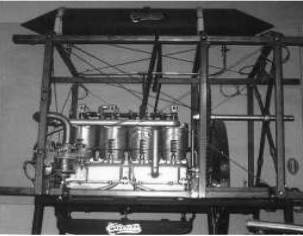
"Curtiss engine on Baldwin bed"
-We can see a part of the "fuselage" or square-section structure of the airship, hanging below the cylindrical gas balloon.
-On top of the structure there is the fuselage fuel tank.
-The third engine presented is the B-8. It is from 1908 and it is an air-cooled V-8 engine.
-Very shiny in the NASM Museum, but without sparkplugs.
-It delivers 40 hp at 1,800 rpm and its displacement is 268 cu.in.
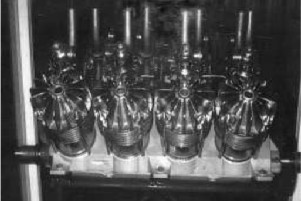
"Curtiss B-8"
-If this can be considered its beginning, along the way, as we will see, Curtiss Aeroplane & Motor Co. changed to Curtiss Engineering Corp (1917) returning to "Curtiss Aeroplane & Motor Corp." and then merged with Wright Aeronautical that had roots in the Wright brothers, pioneers as well.
-There were factories in Garden City, NY. In Hammondsport and Buffalo, NY. And in Wood-Ridge, NJ.
-It started with small piston engines, then the bigger ones in V and the radials that got to the magnificent Turbo-Compound, going through experiences in Wankel engines and making rocket engines and turbojets.
-Wright made the English DH Gipsy, between 1927 and 1934, to which they gave the reference L-320.
-Dealing with the Curtiss models, we will follow a common thread: the initial letter of each engine and some jump in time due to the construction date of each engine.
-Thus, in 1904, the 3 hp, single-cylinder C-1 engine became Curtiss' first engine of exclusive aviation design.
-The A-4 gave 15 hp at 1,800 rpm. and had a displacement of 108 cu. in. It had four in-line cylinders.
-The A-8 with 216 cu. in. of displacement giving 30 hp at 1,800 rpm had 8 air-cooled cylinders in V.
-Possibly the one shown below." Cylinders of the A-8.
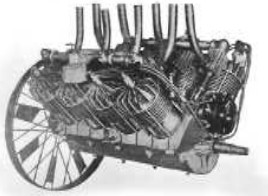
"Curtiss 8 cylinders in V"
-There was an experimental V-12, known as AB in 1917, destined to light-weight fighters with little frontal area. There is no more specific information about this engine.
-The B-4 was a derivative of the A-4, with 20 hp at the same rpm.
-The B-8 from 1907 with 40 hp at 1,800 rpm, with almost 216 cu. in. was an air-cooled V8 weighing 150 lbs.
-Apart from the B-8 shown above -and that certainly seems incomplete- we now provide an engine that is exhibited at the Curtiss Museum, including its carburetors, which do not appear on the engine at the NASM.
-It's a replica anyway.

"B-8 replica"
-Because Glenn Curtis's early days were in the field of motorcycles, he did an experiment of placing a V-8 on a racing motorcycle.

"Curtiss motorcycle with a V-8"

"Curtiss ad"
-We confirm that the C-1 was Curtiss' first aero engine -mentioned earlier- with 27 cu. in. of displacement, weighing 40 pounds, and air cooled.
-The piston bore and stroke was 3.25".
-The C-4 with four upright in-line cylinders gave 25 hp and was air cooled.

"Curtiss C-4"
-The C-6 belongs to a later group of engines made in 1912, with 6 in-line cylinders and was derived from the Kirkham K-6, as we will see.

"Curtiss C-6"
-In the picture above we see a Curtiss C-6 engine exhibited at the Seattle Flight Museum, redesigned from the Kirkham K-6, with four valves per cylinder.
-The same goes for the C-12, derived from the K-12.
-The E-4 was an in-line, 4-cylinder that was Curtiss' first water-cooled engine.
-It gave 50 hp at 1,500 rpm with 393 cu. in., and was built between 1918 and 1923.

"Possible E-4"
-Another E-4 that we show in the picture below is exhibited at the Old Rinebeck Museum (along with a Curtiss I-4).
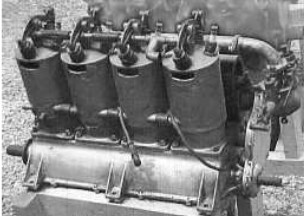
"Curtiss E-4"
-Somewhere above a Curtiss is mentioned as being a possible E-4, It certainly is the one that is shown and that has been mounted on the Baldwin airship.
-The E-8 was an engine from 1909, with 8 cylinders in V, and was a double cylinder row version of the E-4, giving 100 hp at 1,500 rpm. It was the winner at the Rheims Meeting that same year.
-The H and K (in their first stage) were identical, giving 40 hp at 1,500 rpm and as we see in the photo, the radiator was at the rear.
-They had 4 cylinders, a Schebler carburetor and a single Bosch magneto. The displacement was 251 cu. in.
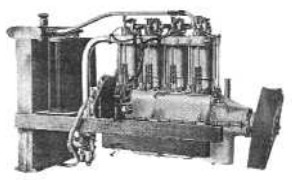
"Curtiss H"
-Do not confuse the Curtiss H with the Wright H. The latter, along with the E-engines were licensed by Hispano Suiza and they also had their marine version as HISSO (name with which the initials HS were known) and and the Hurricanes were the marine H versions, and The Golden Cups the marine E versions.
-From the same style as the H and with six cylinders would come the S model that gave 60 hp. (Year 1912).
-Another engine at the Old Rinebeck Museum is the I-4, that gave 25 hp at 1,200 rpm. In 1912 appears an I-6 or model S.

"Curtiss I-6 or S"
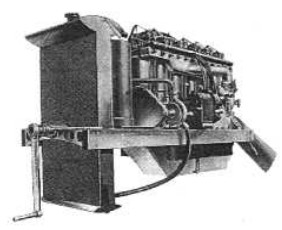
"Curtiss S"
-The "L" models had 8 cylinders in V, were water cooled and gave 80 hp. This engine gave rise to the "O" series, head of an important series of engines, such as the well-known "OX".
-The O gave 75 hp at 1,500 rpm, and was from 1912.
-The 1913 OX-2 gave 85/90 hp at 1,200 rpm with Bendix magneto and Schebler carburetor.
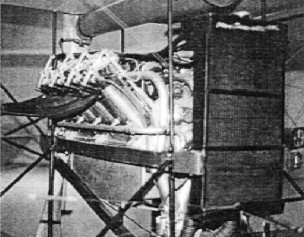
"OX-2 installation"
-The OX-5 was extraordinarily famous, and it was the exact engine for another big airplane, the JN-4 "Jenny".
-For the O and OX there is an anecdote emerged within the factory: it is said that the OX should be the O-plus, represented as O+, but in case there were printing errors, they turned the cross 45° and it became OX.
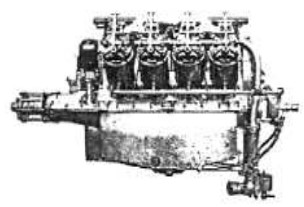
"Curtiss OX-5"
-It had the same displacement as the OX-2 and gave 90 hp, but with Berlin magneto and Zenith carburetor.
-Later we will see the reason for the OXX versions, but now we present the OXX-3 to follow a model order.
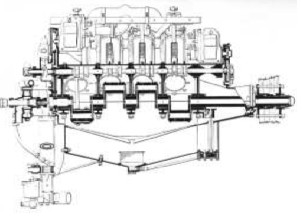
"OXX-3 cross-section"
-The OX-5 were also built by other companies and in quantity for being at war, many of them were sent to England.
-In the OX family we can highlight the following models:
-The OX-2 on the S-3 plane.
-The OX-5 giving 90 / 100 and 115 hp.
-The OX-6 giving 100 hp on the N-9 airplane.
-And the following Navy versions: OXX-2, OXX-3, OXX-5, OXX-6 and PXX-6.
-As an example, the OXX-6 was the Navy version of the OX-5.

"Two views, OX-5"
-There was a version like that of the rare "Tank" that was an air-cooled OX-5. It was mounted on the Curtiss Robin plane.
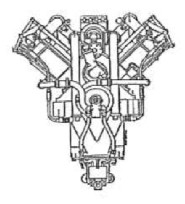
"OX-5 diagram"
-The OX-5 had a characteristic that differentiated it from the other engines: the two valves of each cylinder were not aligned with the axis of the engine but transversally, so that it needed a system of rods inside one another, being the tubular exhaust.

"OX-5 top view"
-In the illustration we see the distribution mechanism and also the place of the magneto between the two cylinder banks. The OXX had double ignition.

"Curtiss OX-5, old"
-As a tribute to this great engine, the photograph of an OX-5 in its current situation, rusty, waiting for its restoration.
-There were derivatives of the OX-5 with 12 cylinders in V, as we see in two images from a brochure from the Curtiss company itself.
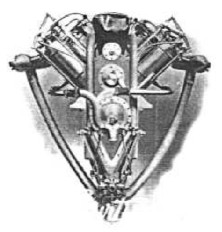
"Curtiss OX"
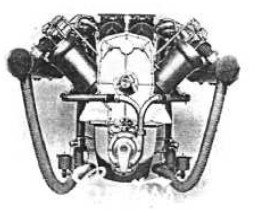
"Curtiss VX"
The OX with 100 hp, and the VX gave 200 hp at 1,400 rpm. In both we see that the exhausts are directed to heat the carburetors. In fact they were contemporaries. See the V-12 with 250 hp from the photo further below.
-The V-2 and V-3 had 8 cylinders in V, and had more refined shapes. The V2 gave 180 hp and the V-3 200 hp. The first V engine was made towards 1914. Both had a displacement of 1010 cu. in.
-As we will see in the front view and the right side view, there is a Zenith carburetor on each side and the ducts run between the central cylinders to the upper intake manifolds.
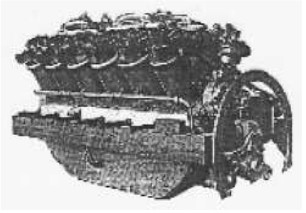
"Curtiss V-12"
-As we said the V-2 is an 8-cylinder V engine with double ignition.

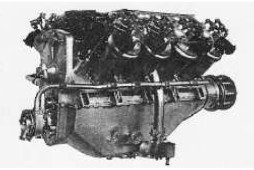

"Curtiss V-2"
-The V-3 was also a water-cooled 90° 8-V. It has been written that it started with 160 hp (instead of 200 hp from another source).
-They were designed by Charles Manly. There is an anecdote that Russia acquired 3 of these engines and that they never arrived, as the the ship that carried them was sunk by a German submarine.

"Curtiss V-3"
-In the 1920's, after WWI, Curtiss returns to the engine description with letters like C, D, K, etc. It was applied to more modern engines.
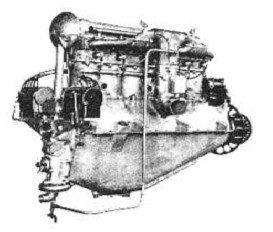
"Curtiss C-6"
-Other engines like the C-6 and C-12 were redesigns of the K-6 and K-12.
-In these last ones, Charles B Kirkham intervened (see Kirkham). The main feature was that both the lower half-shell and the cylinder block were a single cast aluminum piece.
-The inner sleeves were in direct contact with water. The basically identical C-6 and K-6 had 6 cylinders in-line and gave around 150 hp with direct output from the crankshaft to the propeller.
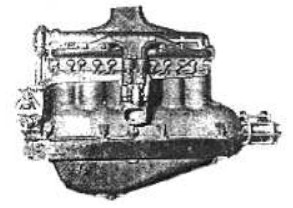
"Curtiss K-6"
-The same thing happens with the C-12 and the K-12 from the same designer, giving between 375 and 400 hp. They were geared V-12 engines.
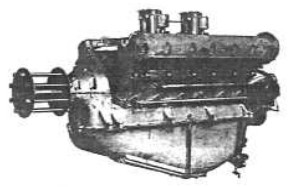
"Curtiss C-12"
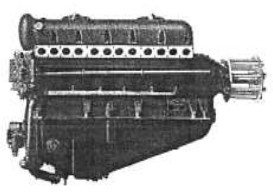
"Curtiss K-12"
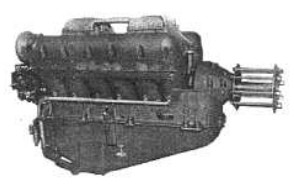
"Another K-12"
-They were geared from 1 to 0.6, and had four valves at the top of each cylinder. The compact form of the engine can be seen from the rear, which facilitates the installation on competition or combat aircraft.
-It has records of altitude without compressor and intervened in several raids.
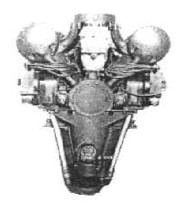
"Curtiss K-12, rear"
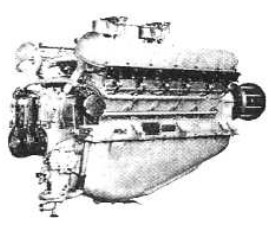
"Curtiss C-12"
-The C-12 gave way to the CD-12. And the D-12 to new V-12 engines, beginning already with 435 hp without gear. (1921-1922).
-From these engines came different series like the D-12A, C, D, E, F, M, etc.
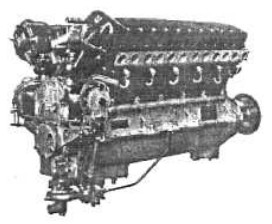
"Curtiss D-12"
-The engines also evolved in displacement from the V-1150, the V-1400 (from 1925 giving 620 hp), the V-1460, the V-1550 (from 1926 giving 600 hp, considered an enlarged D), and the V-1570.
-The D-12 was designed for the races in 1921-1922. It was made in England by Fairey where it was known by the name "Felix" (see).
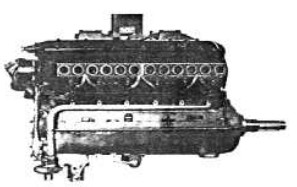
"Curtiss V-1550"
-The V-1400 was a direct derivative of the D-12 giving surprising results in the 1925 Pulitzer and Schneider races. Although the volume and overall size was less than the D-12, the cylinders were larger and gave more power.
-The V-1550, from 1926, gave 575/600 hp. It is derived from the D-12 as well. There was also a geared version, GV-1550.

"Curtiss GV-1550"
-The V-1570 was an important engine, also derived from the D-12, and redesigned by Arthur Nutt, in 1931, giving 700 CV and known as "Conqueror", with exactly 1569 cu. in. of displacement.
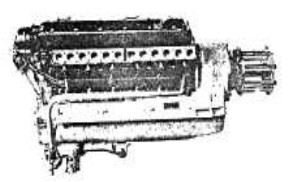
"Curtiss GV-1570"
-The V-1570 "Super Conqueror" geared variant from 1933 gave 800 hp. It was the GV-1570.
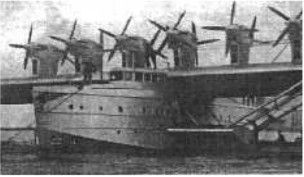
"Dornier Do-X"
-The "Conqueror" had its most notable installation on the Dornier Do-X with 12 engines per plane. Each engine gave 600/650 hp.
-There was an IV-1460 with twelve air-cooled cylinders in inverted-V.
-With 1947 cubic inches they made the "T" series (T1, T2 and T3) known as "Tornado". They were water-cooled V-12 engines. See Wright.
-Relating to the co-productions we would not forget that during WWI they also made the "Liberty".
-The Hispano Suiza engines mentioned as H and E series and HISSO. They also made the Gipsy engines.
-Thereafter we get to supercharged engines used in WWII, such as those of the B-17, B-24, P-38 or P-47. And later on the B-29s, B-50s or the civilians Boeing Stratocruiser, etc.
-These tests occurred in the 1920's, as was the case with the Curtiss P-5 powered by a Curtiss D-12F that gave 460 hp.
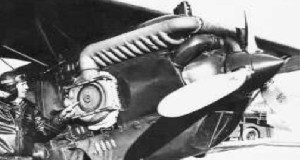
"Turbo-supercharger on the P-5"
-Below a Curtiss advertisement from 1916 for the 160 hp engine.
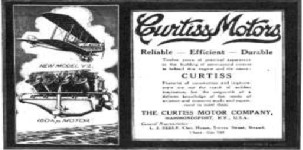
"Curtiss advertisement"
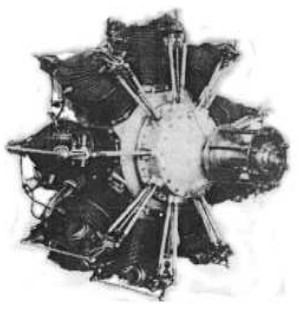
"Curtiss P-1"
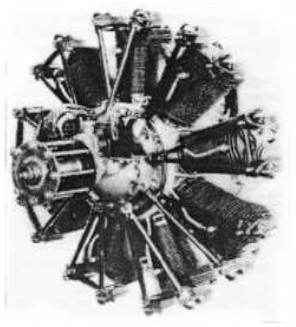
"Curtiss P-2"
-In radial engines, Curtiss-Wright started with the Lawrance J4 3-cylinder, built as Wright "Gale".
-The J3, J5 and J6, the latter as Wright" Whirlwind. "
-The radial "Cyclone" P-1 was the first prototype of this family, followed by the P-2. Both were 9-cylinder engines.
-The P1 had the valves aligned with the flying direction, emphasizing the mechanism that operate the rear part, while the P2 had them parallel, the classic way.
-The Curtiss R-1454 with a different valve mechanism that characterizes it.
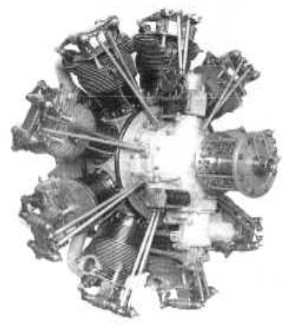
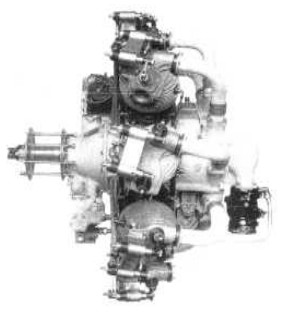
"R-1454"
-In 1927, an enlarged Cyclone was made, the R-1750, with a completely new design. Later these would be the R-1820s.

"R-1750"

"R-1820"
-By 1951 there was the R-1820 Turbo-Compound version.
-A system that recovered the kinetic force that remained from the exhaust gases so that through two recovery turbines an additional hp was added to the crankshaft.
-This system had its maximum expression in the R-3350 "Turbo-Compound" that we saw in the "Seven Seas", "Super-Constellations" and military aircraft like the Neptune, etc.

"R-1820 Turbo-Compound"
-There was a Cyclone variant of 7 cylinders, the R-1300 from 1946. This one gave rise to the 14-cylinder Cyclones, the R-2600.
-The R-1200 was the 9-cylinder "Simoon" with a displacement of 1176 cu. in.
-In 1929 appeared a 5-cylinder radial derived from the J6 "Whirlwind". It became known as the R-540.
-There were three types of this engine family: the R-540, R-760 and the R-975. They all were called "Whirlwind".
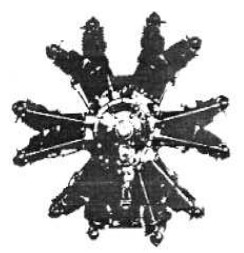
"R-600"
-The R-600, had 6 cylinders in two rows of 3 cylinders each. It was known as the "Challenger".
-A photo with a rear view of the Challenger has been located. It had six cylinders in two rows of three.

"Curtiss-Challenger"
-Another engine with six in-line inverted cylinders, barely known, was the "Crusader" that gave 120 hp.
-However, those who did impact were the Chieftains. There were two of them, the H-1640 and the H-2120.
-These twelve-cylinder radials with two rows of six were known as the "Hexagon" and in which the hexagonal shape is guessed.
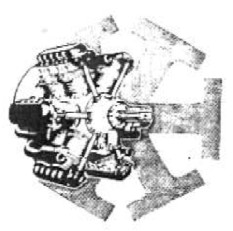
"Chieftain"
-The H-1640 was air cooled. The cam shafts on the cylinder heads operated two cylinders at the same time. It gave 600 hp.
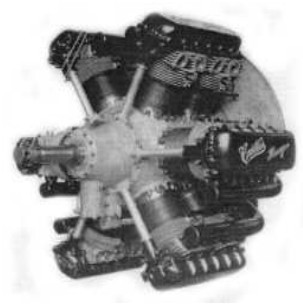
"H-1640"
-We received another view of the Chieftain with 600 hp. It has twelve cylinders in two rows, but aligned as we can see. Each two cylinders have their own camshaft over head, OHC.

"Chieftain, 600 HP"
-The H-2120, of equal disposition but liquid cooled.
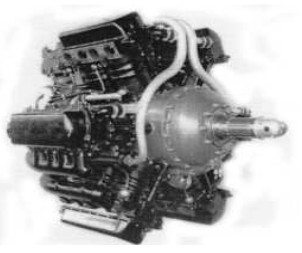
"H-2120"
-The intention of the "Chieftain" project was to compete with the new P & W "Wasp", offering smaller frontal area among other advantages.
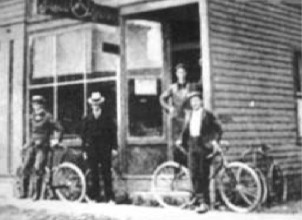
"Curtiss' bicycle shop"
-The difference was that while the Wrights lived an ephemeral life, leaving their invention in the hands of bankers during the following decade, the Curtiss story continued much longer, although his name became involved with Wright again when joining both names . See Curtiss, Wright, and Curtiss-Wright.
-Logically, it did not take long before he mounted an engine on his bicycles. We see a model below, although the one shown in the main text already has a larger air-cooled V8 engine.

"Curtiss motorcycle"
-The two-cylinder V-engine would be used in another device resulting from a Curtiss invention: a vehicle with wheels driven by a propeller.

"Curtiss on his device”
-In the main text we see that he made several engines in a line, including his previously mentioned air-cooled V8 and its water-cooled variants.

"Another example of slider with larger engine"
-As we know, he was quickly introduced into the incipient motorized aviation started by the Wright brothers but he got the No. 1 pilot license in the United States.
-He made his own airplanes and made numerous demonstrations. Selling his products in various parts of the world as well.
-A photograph from Popsci (PiP) shows a rather young Glenn H. Curtiss at the controls of a device built by himself.
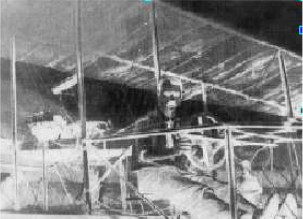
“Curtiss at the controls” (PiP=ps)

"And after a demonstration flight in New York"
-In both cases we see his devices with V-8 engines, an architecture that Curtiss bet on from his beginnings in this field.
-We remember that the Wright brothers used four-cylinder in-line engines with less power.
-At the San Diego Museum there is an OX-5 engine of this brand, completely chromed. This is not normal but it looks like a jewel, a real "extravaganza".
-All sponsored by the Association of "Aviation Pioneers Historians" in San Diego.

"Curtis OX-5 engine, chrome"
-As we know from the main text, it is a V8 at 90°, from 90 hp at 1,400 rpm, no gear required. It weighs about 390 lbs, and has a Zenith Duplex carburetor and simple ignition.
-Below three views of other OX-5 engines from several USA Museums. This first engine is sectioned and we assume that this is done for didactic purposes. We can see the magneto at the rear.

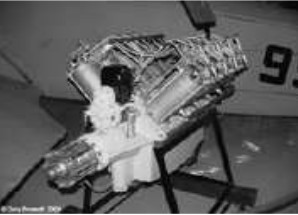
"OX-5 variants"
-In this second engine, the magneto is on the front.
-In the following photograph, also provided through the "Aircraft Engine Historical Society", we have a complete lateral view where the rockers are clearly seen, intercalated due to the original valve arrangement.

"OX-5 side view"
-Instead of having the cylinder valves longitudinal aligned in the direction of the engine, they are crossway.
-The rockers intercalated this way, imply that the push rods coincide in the same place and therefore one is hollow and the other passes through its interior. They are concentric.
-In a last visit to the Smithsonian Museum in Washington we pick up three new pictures of Curtiss engines that are less documented in the main text.
-First, the two-cylinder V, designed for Motorcycles in 1904. Conveniently modified it was used in an airship in 1905 and renamed A-2, Its power was 7 hp at 1,500 rpm.
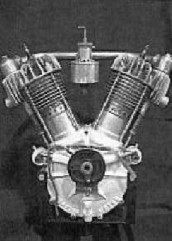
"Curtiss A-2"
-The other still air-cooled engine is the B-8 -thereafter they would all be liquid-cooled-. They gave 40 hp at 1,800 rpm, and were from 1908.
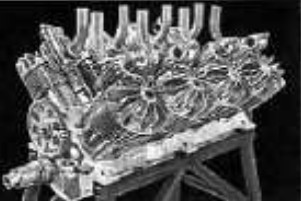
"Curtiss B-8"
-The K model, not presented in the main text, has four in-line upright cylinders that were water cooled. It had an important success in the beginning of aviation.
-These engines were designed by pioneer Glenn H. Curtiss and were built by his company Curtiss Airplane and Motor Co. in Hammondsport, NY.
-The K gave 40 hp at 1,500 rpm. Each cylinder had a single-valve that operated with a single rod, opening the intake and exhaust passages by different routes.

"Model K"
-Curiously, these three engines at this important Museum are mutilated, lacking magnetos, and so on.
-This in-line upright four-cylinder engine is from the earliest epoch when Glenn Curtiss was pioneering.
-The main text mentions the A-4 engine, which is possibly the one that we show now below. Information provided by R. Loftis from AEHS.
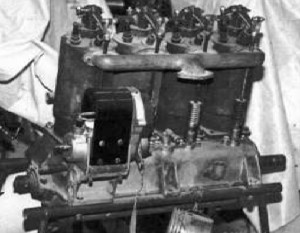
"Possible Curtiss A-4" (AEHS)
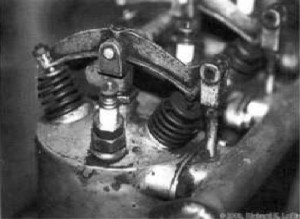
"Detail of the single rocker per cylinder" (AEHS)
-We located some Curtiss engines at the San Diego Museum. First an OX-2.
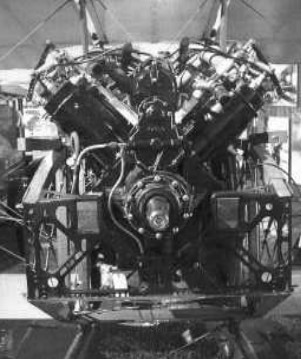
"Curtiss OX-2"
-And an 8-cylinder V-engine. See main text.

"Curtiss V8 engine"
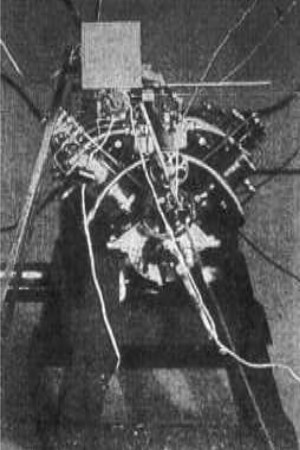
"Curtiss V8 on the bench"
-One of the first Curtiss water-cooled engines after the OX-5, was the V8 as shown above on a test bench and below installed on the "Silver Dart" aircraft.
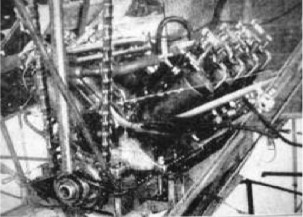
"On the Silver Dart, with chain transmission"
-Several water-cooled Curtiss V8s were modified for marine as we see in the photograph below.

"Curtiss for fast canoeing"
-The version with 12 cylinders in V was the V4 - see main text - and one of these engines is conserved at the NASM in Washington. It may be the V-12.
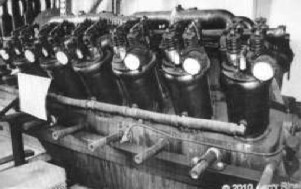
"V4 at the Smithsonian, Photo by Larry Rinek"
-But later the V12 type Conqueror and other Curtiss engines were famous for giving high performances to the machines on which they were mounted.
-For example, the Curtiss Hawk fighter became the fastest single-seater fighter in the world in its time.
-We add some better views of Curtiss engines that appear in the main text plus others that are only mentioned as the Curtiss VX and AB from 1916, the D-1200 from 1917, the K-12 from 1918, the CD-12 from 1920 and the D -12 from 1922.
-The evolution of the D-12 began as a variant of the C-12, first as CD-12 in 1920 and then CD-12A, and finally in 1922 the D-12 giving 375 hp, the D-12C in 1925 giving 435 hp.
-The D-12D in 1926 giving 460 hp. The D-12E the following year, 1927, with 435 hp.
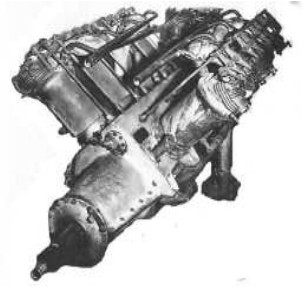
"Curtiss V-X"

"Curtiss A-B"
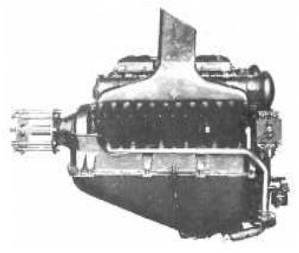
"Curtiss D-1200"

"Curtiss K-12"
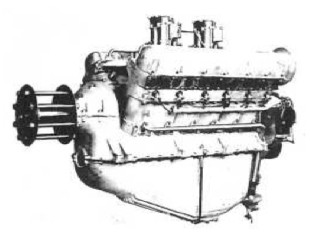
"Curtiss C-12"

"Curtiss D-12"

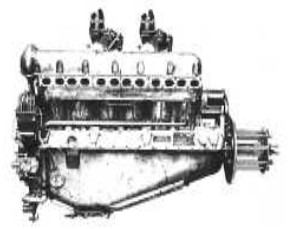
"Curtiss CD-12"

"In the Curtiss emphasize the exhaust pipes"

"Front-top view of the same engine"
-Looking at the Hawk our attention goes to the "slope" of the water-radiator-intake under the engine that gives a characteristic shape to the airplane.
-Each exhaust pipe corresponds to an exhaust valve, each cylinder has two exhaust and two intake valves.
-Referring to experimental engines, they made an atypical in-line, six-cylinder R6 in 1921 for experimental purposes.
-Seen at the Smithsonian.
-They incorporated the Ricardo supercharging system to increase power at high altitudes and to save fuel as well.
-The principle was that each piston compressed the air in its inferior part so that it entered with greater pressure to the top of the piston while passing by an intercooler.
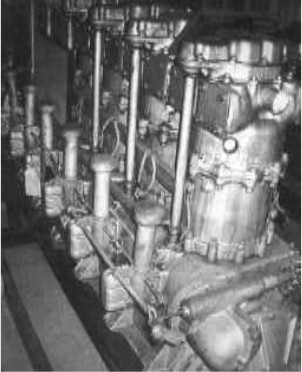
"Curtiss R6, Photo by Larry Rinek"
-He did not convince the US Navy, for not having compensated the weight gain.
-A flawless Curtiss C-6 engine has been located at the "Wings Over the Rockies" Museum in Denver, Colorado, USA.
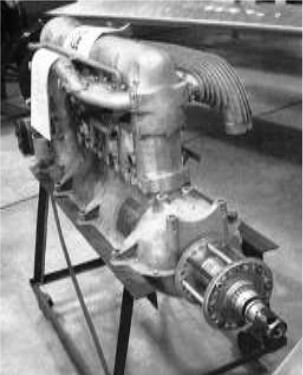
"Curtiss C-6"
-As mentioned before, it was a redesign of Kirkham.
From Appendix 7: An OX-5 rating plate.
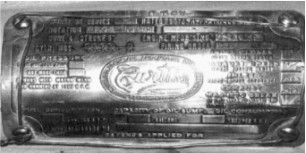
"Plate details"
From Appendix 9: Two new illustrations. One of them is from a first V8, it looks like an OX-2 installed on a plane in "pusher" position - see propeller shape.
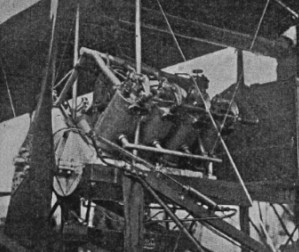
"The shape of the crankcase at the power outlet is flat"
-The following illustration, more than an OX-5, it looks like a "V" because of the oil-pan shape.
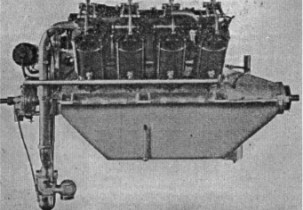
"Curtiss V8, more modern"
Go to Curtiss part 2
Engines of CURTISS (Part 1)
Model: 1400, SCO, SCOS, SGV (V-1400)
Arquitecture: V-Engine
Cooling:
Total Displacement:
Bore / Stroke:
Power: @ rpm
Weight:
See V-1400
Model: 25/30 HP
Arquitecture:
Cooling:
Total Displacement:
Bore / Stroke:
Power: @ rpm
Weight:
Model: 37/45 HP
Arquitecture:
Cooling:
Total Displacement:
Bore / Stroke:
Power: @ rpm
Weight:
Model: A-2
Arquitecture: 2-cylinder V-Engine
Cooling: Air
Total Displacement: 60 cu. in.
Bore / Stroke:
Power: 7 HP @ 1200 rpm
Weight:
It was initially installed on the first airship of the US Signal Corps: the Thomas Scott Baldwin.

"Curtiss A-2"
Model: A-4
Arquitecture: 4-cylinder In-line
Cooling: Air
Total Displacement:
Bore / Stroke:
Power: 15 HP @ 1800 rpm
Weight:

"Possible Curtiss A-4"
Model: A-8
Arquitecture: 8-cylinder V-Engine
Cooling: Air
Total Displacement: 216 cu. in.
Bore / Stroke:
Power: 30 HP @ 1800 rpm
Weight:
Model: AB
Arquitecture: 12-cylinder V-Engine
Cooling: Air
Total Displacement:
Bore / Stroke:
Power: @ rpm
Weight:
Experimental engine.

"Curtiss A-B"
Model: B-4
Arquitecture: 4-cylinder In-line
Cooling: Air
Total Displacement:
Bore / Stroke:
Power: 20 HP @ 1800 rpm
Weight:
Model: B-8
Arquitecture: 8-cylinder V-Engine
Cooling: Air
Total Displacement: 268 cu. in.
Bore / Stroke:
Power: 40 HP @ 1800 rpm
Weight:
Weight: 150 lbs.

"B-8 replica"
Model: C-1
Arquitecture: Single-cylinder
Cooling: Air
Total Displacement: 27 cu. in.
Bore / Stroke: 3.25 x 3.25 inch
Power: 3 HP @ rpm
Weight: 40 Lb
It was Curtiss' first engine of exclusive aviation design.
Model: C-12
Arquitecture: 12-cylinder V-Engine
Cooling: Liquid
Total Displacement:
Bore / Stroke:
Power: 375 / 400 HP @ rpm
Weight:
They were geared from 1 to 0.6, and had four valves at the top of each cylinder. They were derived from the K-12

"Curtiss C-12"
Model: C-2
Arquitecture:
Cooling:
Total Displacement:
Bore / Stroke:
Power: @ rpm
Weight:
Model: C-4
Arquitecture: 4-cylinder In-line
Cooling: Air
Total Displacement:
Bore / Stroke:
Power: 25 HP @ rpm
Weight:

"Curtiss C-4"
Model: C-6
Arquitecture: 6-cylinder In-line
Cooling: Liquid
Total Displacement:
Bore / Stroke:
Power: 150 HP @ rpm
Weight:
It had four valves per cylinder.

"Curtiss C-6"
Model: CD-12
Arquitecture: V-Engine
Cooling:
Total Displacement:
Bore / Stroke:
Power: 435 HP @ rpm
Weight:
Without gear.

"Curtiss D-12"
Model: D-12
Arquitecture: V-Engine
Cooling:
Total Displacement:
Bore / Stroke:
Power: 435 HP @ rpm
Weight:
The supercharged D-12F gave 460 hp.

"Curtiss D-12"
Model: D-1200
Arquitecture:
Cooling:
Total Displacement:
Bore / Stroke:
Power: @ rpm
Weight:

"Curtiss D-1200"
Model: E-4
Arquitecture: 4-cylinder In-line
Cooling: Liquid
Total Displacement: 393 cu. in.
Bore / Stroke:
Power: 50 HP @ 1500 rpm
Weight:
Curtiss' first water-cooled engine.

"Curtiss E-4"
Model: E-8
Arquitecture: 8-cylinder V-Engine
Cooling: Liquid
Total Displacement:
Bore / Stroke:
Power: 100 HP @ 1500 rpm
Weight:
Model: GV-1550
Arquitecture: V-Engine
Cooling:
Total Displacement:
Bore / Stroke:
Power: HP @ rpm
Weight:
Geared version from the V-1550.

"Curtiss GV-1550"
Model: GV-1570, (SGV) Super Conqueror
Arquitecture: 12-cylinder V-Engine
Cooling: Liquid
Total Displacement: 1569 cu. in.
Bore / Stroke:
Power: 800 HP @ rpm
Weight:
Geared version from the V-1570.

"Curtiss GV-1570"
Model: H
Arquitecture: 4-cylinder In-line
Cooling: Liquid
Total Displacement: 251 cu. in.
Bore / Stroke:
Power: 40 HP @ 1500 rpm
Weight:
They had a Schebler carburetor and a single Bosch magneto.
Model: H-1640, Chieftain
Arquitecture: 12-cylinder Radial
Cooling: Air
Total Displacement:
Bore / Stroke:
Power: 600 HP @ rpm
Weight:
These twelve-cylinder radials with two rows of six were known as the "Hexagon". The cam shafts on the cylinder heads operated two cylinders at the same time.

"H-1640"
Model: H-2120 (Chieftain)
Arquitecture: 12-cylinder Radial
Cooling: Liquid
Total Displacement:
Bore / Stroke:
Power: @ rpm
Weight:

"Curtiss H-2120"
Model: H-4
Arquitecture:
Cooling:
Total Displacement:
Bore / Stroke:
Power: @ rpm
Weight:
Model: I-4
Arquitecture: In-line
Cooling:
Total Displacement:
Bore / Stroke:
Power: 25 HP @ 1200 rpm
Weight:
Model: IS-470 Crusader
Arquitecture: 6-cylinder In line inverted
Cooling:
Total Displacement:
Bore / Stroke:
Power: 120 HP @ rpm
Weight:
Model: IV-1460
Arquitecture: 12-cylinder Inverted V-engine
Cooling: Air
Total Displacement: 1460 cu. in.
Bore / Stroke:
Power: @ rpm
Weight:
Model: K
Arquitecture: 4-cylinder In-line
Cooling: Liquid
Total Displacement: 251 cu. in.
Bore / Stroke:
Power: 40 HP @ 1500 rpm
Weight:
It had a Schebler carburetor and a single Bosch magneto.

"Curtiss K model"
Model: K-12
Arquitecture: 12-cylinder V-Engine
Cooling: Liquid
Total Displacement:
Bore / Stroke:
Power: 375 / 400 HP @ rpm
Weight:
They were geared from 1 to 0.6, and had four valves at the top of each cylinder.

"Another Curtiss K-12"
Model: K-6
Arquitecture: 6-cylinder In-line
Cooling:
Total Displacement:
Bore / Stroke:
Power: 150 HP @ rpm
Weight:
It had direct output from the crankshaft to the propeller.

"Curtiss K-6"
Model: L-2
Arquitecture:
Cooling:
Total Displacement:
Bore / Stroke:
Power: @ rpm
Weight:
Model: L-320 (Gypsy, Lic.)
Arquitecture:
Cooling:
Total Displacement:
Bore / Stroke:
Power: @ rpm
Weight:
Model: L-6
Arquitecture:
Cooling:
Total Displacement:
Bore / Stroke:
Power: @ rpm
Weight:
Model: Liberty (WWI)
Arquitecture:
Cooling:
Total Displacement:
Bore / Stroke:
Power: @ rpm
Weight:
Model: Marine 1, 2
Arquitecture:
Cooling:
Total Displacement:
Bore / Stroke:
Power: @ rpm
Weight:
Model: O
Arquitecture: V-Engine
Cooling:
Total Displacement:
Bore / Stroke:
Power: 75 HP @ 1500 rpm
Weight:
Model: OX-2
Arquitecture: 8-cylinder V-Engine
Cooling: Liquid
Total Displacement:
Bore / Stroke:
Power: 85 / 90 HP @ 1200 rpm
Weight:
It had a Bendix magneto and Schebler carburetor.

"Curtiss OX-2"
Model: OX-5
Arquitecture: 8-cylinder V-Engine
Cooling:
Total Displacement: 503 cu. in.
Bore / Stroke: 4 x 5 inch
Power: 90 / 100 HP @ 1400 / 1800 rpm
Weight: 390 Lb
The two valves of each cylinder were not aligned with the axis of the engine but transversally, so that it needed a system of rods inside one another, being the tubular exhaust.

"Curtiss OX-5 variant"
Model: OX-6
Arquitecture: 8-cylinder V-Engine
Cooling:
Total Displacement:
Bore / Stroke:
Power: 100 HP @ rpm
Weight:
Model: OXX-2
Arquitecture:
Cooling:
Total Displacement:
Bore / Stroke:
Power: @ rpm
Weight:
Model: OXX-3
Arquitecture:
Cooling:
Total Displacement:
Bore / Stroke:
Power: @ rpm
Weight:

"OXX-3 cross-section"
Model: OXX-5
Arquitecture:
Cooling:
Total Displacement:
Bore / Stroke:
Power: @ rpm
Weight:
Model: OXX-6
Arquitecture: 6-cylinder V-Engine
Cooling: Liquid
Total Displacement:
Bore / Stroke:
Power: @ rpm
Weight:
Navy version for OX-5. As with all OXX versions, it has double ignition.
Model: P-1, radial
Arquitecture: 9-cylinder Radial
Cooling:
Total Displacement:
Bore / Stroke:
Power: @ rpm
Weight:

"Curtiss P-1"
Model: P-2, radial
Arquitecture: 9-cylinder Radial
Cooling:
Total Displacement:
Bore / Stroke:
Power: @ rpm
Weight:

"Curtiss P-2"
Model: PXX-6
Arquitecture:
Cooling:
Total Displacement:
Bore / Stroke:
Power: @ rpm
Weight:
Model: R-1454
Arquitecture:
Cooling:
Total Displacement:
Bore / Stroke:
Power: @ rpm
Weight:

"Curtis R-1454"
Model: R-6, Exp.
Arquitecture: 6-cylinder In-line
Cooling:
Total Displacement:
Bore / Stroke:
Power: @ rpm
Weight:
They incorporated the Ricardo supercharging system.

"Curtiss R6, Foto by Larry Rinek"
Model: R-600, Challenger
Arquitecture: 6-cylinder Radial
Cooling:
Total Displacement:
Bore / Stroke:
Power: @ rpm
Weight:
The R-600, had 6 cylinders in two rows of 3 cylinders each.

"Curtiss-Challenger"
Model: S, 6 cyl, (I-6)
Arquitecture: 6-cylinder In-line
Cooling: Liquid
Total Displacement:
Bore / Stroke:
Power: 60 HP @ rpm
Weight:

"Curtiss S"
Model: T-1, Tornado
Arquitecture: 12-cylinder V-Engine
Cooling: Liquid
Total Displacement:
Bore / Stroke:
Power: @ rpm
Weight:
Model: T-2, Tornado
Arquitecture: 12-cylinder V-Engine
Cooling: Liquid
Total Displacement:
Bore / Stroke:
Power: @ rpm
Weight:
Model: V-1150
Arquitecture: V-Engine
Cooling:
Total Displacement: 1150 cu. in.
Bore / Stroke:
Power: @ rpm
Weight:
Model: V-12
Arquitecture:
Cooling:
Total Displacement:
Bore / Stroke:
Power: @ rpm
Weight:

"Curtiss V-12"
Model: V-1400
Arquitecture: V-Engine
Cooling:
Total Displacement: 1400 cu. in.
Bore / Stroke:
Power: 620 HP @ rpm
Weight:
The V-1400 was a direct derivative of the D-12.
Model: V-1460
Arquitecture: V-Engine
Cooling:
Total Displacement: 1460 cu. in.
Bore / Stroke:
Power: @ rpm
Weight:
Model: V-1550
Arquitecture: V-Engine
Cooling:
Total Displacement: 1550 cu. in.
Bore / Stroke:
Power: 600 HP @ rpm
Weight:
It is derived from the D-12.

"Curtiss V-1550"
Model: V-1570, Conqueror
Arquitecture: V-Engine
Cooling:
Total Displacement: 1569 cu. in.
Bore / Stroke:
Power: 700 HP @ rpm
Weight:
This engine was derived from the D-12, and redesigned by Arthur Nutt, in 1931.
Model: V-2
Arquitecture: 8-cylinder V-Engine
Cooling: Liquid
Total Displacement: 1010 cu. in.
Bore / Stroke:
Power: 180 HP @ rpm
Weight:
It is an engine with double ignition.There is a Zenith carburetor on each side and the ducts run between the central cylinders to the upper intake manifolds.

"Curtiss V-2 (8 cyl.) fig2"
Model: V-3
Arquitecture: 8-cylinder V-Engine
Cooling: Liquid
Total Displacement:
Bore / Stroke:
Power: 160 / 200 HP @ rpm
Weight:
Engine with 90° V.

"Curtiss V-3"
Model: V-4
Arquitecture: 12-cylinder V-Engine
Cooling:
Total Displacement:
Bore / Stroke:
Power: @ rpm
Weight:

"Curtiss V4 at the Smithsoniano, Photo by Larry Rinek"
Model: V-8
Arquitecture:
Cooling:
Total Displacement:
Bore / Stroke:
Power: @ rpm
Weight:

"Curtiss V8 engine"
Model: VX
Arquitecture: 8-cylinder V-Engine
Cooling: Liquid
Total Displacement:
Bore / Stroke:
Power: 200 HP @ 1400 rpm
Weight:

"Curtiss V-X"


